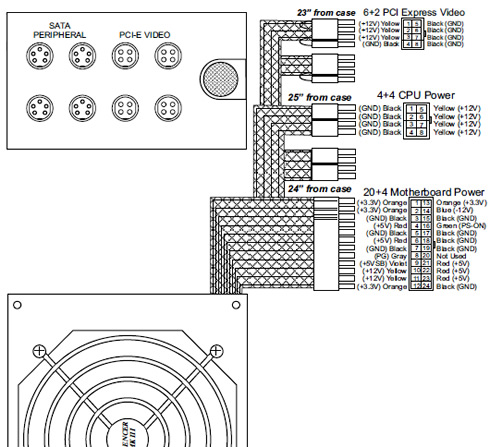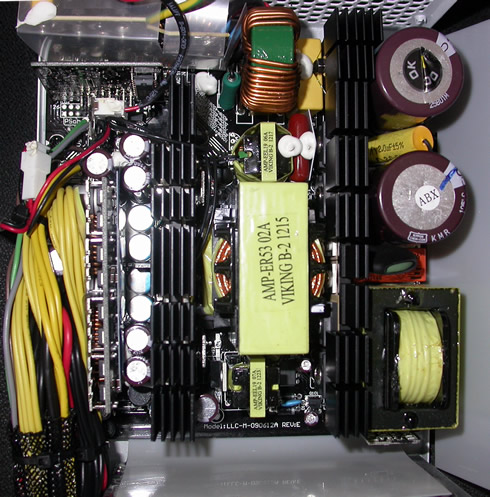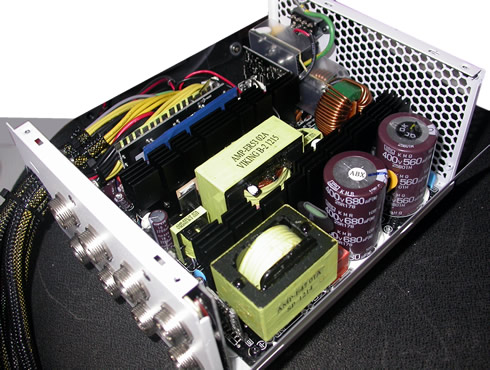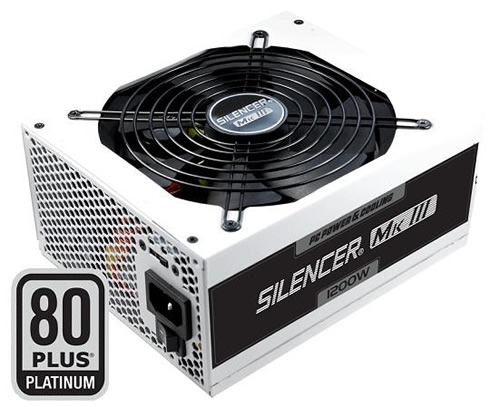1. Features, specs
We have in our labs the Silencer Mk III 1200W (PPC MK3S1200) power supply unit from PC Power & Cooling, an OCZ Group company. The power supply has been designed to meet the power demands of game rigs, by providing a massive 1200 wattage along with high efficiency and convenience and flexibility through a modular cable design.
The Mk III 1200W is the Silencer Series’ most powerful solution yet. It meets the 80 Plus Platinum certified rating and promises an over 92% efficiency at typical workloads. The Mk III combines a single +12V rail, high-quality components including 100% Japanese 105°C capacitors, and protection circuits while maintaining continuous, stable output at a 50°C ambient temperature.
A new feature on this latest model is the Dual Thermal Control System, an operation that allows the user to switch the PSU between normal and silent mode seamlessly, working in conjunction with the load and temperature controlled 140mm fan for quiet operation.
The Silencer Mk III 1200W Series comes backed with PC Power’s 7 year warranty and retails for $300.

- Features
- 1200W Continuous @ 50C
- SLI and CrossFire Ready
- 80-Plus Platinum Certified (92% Efficiency); .98 Active PFC
- 140mm double ball-bearing fan
- Up to 90% (10dB) Less Noise per Watt
- +12VDC @99.5A (Powerful Single Rail)
- Components with 100% Japanese 105°C Capacitors
- Modular Cabling Design
- Dual Thermal Control System: Normal and Silent Operation
- 7-Year Warranty and Tech Support
Specifications
| AC Input |
| Operating Range: |
115-240 VAC
0.98 power factor
|
| Frequency: |
50/60Hz |
| Current: |
15A
|
| Efficiency: |
92% typical load (80+ Platinum)
|
| EMI: |
FCC Class-B, CE
|
| DC Output |
| Output: |
+3.3V@20A,+5V@20A,+12V@99.5A,
-12V@0.5A,+5VSB@2.5A
|
| Regulation: |
3% (+3.3V, +5V, +12V)
5% (-12V, +5Vsb)
|
| Ripple: |
1% (p-p)
|
| Hold Time: |
40ms minimum
|
| PG Delay: |
100-500ms
|
| Safety |
| Over Voltage Protection: |
+3.3V, +5V, +12V
|
| Over Current Protection: |
135% OPP
|
| Agency Approval: |
cTÜVus, CB, TÜV, CCC, C-tick, GOST, BSMI, China RoHS, WEE, RoHS
|
| Environmental |
| Temperature: |
0-50°C
|
| Humidity: |
10-90%
|
| Fan Type: |
140mm, ball bearing, thermally controlled
|
| Miscellaneous |
| Compatibility: |
ATX12V & EPS12V
|
| M/B Connectors: |
1 x 20+4-pin ATX
2 x 4+4-pin CPU
|
| Video Connectors: |
6 x 6+2-Pin PCI-E
|
| Drive Connectors: |
4 x Peripheral
12 x 5-pin SATA
1 x FDD Adapter
|
| MTBF: |
100,000 Hours
|
| Dimensions/Harness: |
150mm (W) x 86mm (H) x 180mm (L)
|
| Power Cord: |
US, EU, UK, CN, AU, JP, KCC
|
| Warranty: |
7-Years
|
|
2. Opening the box
Below you see the white package if the PSU, with its wattage, the 80PLUS Gold certification and the 7-year warranty of the unit to be prominently displayed.

The back of the box lists the technical specifications of the PSU, its basic features along with an explanation of the Dual Thermal Control System. Using a slider switch found at the rear side of the PSU you can set the fan mode to Silent Mode or Normal Mode. Normal mode ensures that the fan is always running and thermally controlled. Silent mode forces the fan off until the unit reaches 50% load at which it then becomes thermally controlled:


The sides of the box also give the cable and connector availability list:
Inside the box there is the PSU surrounded by foam, wrapped in a cloth bag and sealed in plastic within.
Bundled with the Silencer is a manual, mains cable, screws and a set of cable ties.



The black bag you see above includes the modular cables. Each one has a metal connector instead of the plastic you typically see in PSU cables. It is said that is said to provide better and more stable electrical connectivity than regular plastic modular plugs:

Let's have a closer look to the main unit. Like the MK3 units, this PSU is painted white color. It's metallic case is mat and all of its corners are rounded for easier and handling.

On the top side there is a massive Ong Hua fan running on 0.36A and has a 2000rpm maximum speed. As we previously mentioned, there is a fan switch on the back of the PSU and this allows us to select two modes. In the first the fan is always on and temperature controlled. In mode 2 it is fanless up to 50% load and temperature controlled as required.



The interesting sides of the PSU is the one with the 8 modular sockets. They are four 6-pin connectors for peripheral cables and four 4-pin for PCI-E cables. These are made out of metal and are actually 4-pin and 6-pin male connectors, with screw caps used to attach the wiring (the modular cables.) As we earlier saw, each module cable also features a female metallic connector.

All the male connectors on the PSU are protected by silicone cap, which should be of course removed when you plug in cable. It would be also decent not to keep any unused connectors uncapped, as this could cause a short. But even in that rare case, the PSU's Short Circuit Protection would kick in to instantly shut the PSU down and protect it.


All native cables are also fully sleeved back into the housing, and around the cable exit-hole is a grommet to protect cabling from sharp edges.
The back side is standard with the honeycomb venting as well as the AC input, the on/off and the Dual Thermal Control System switches:

3. A closer look
The power supply utilizes a single 12V rail design to deliver most of the power for the unit. In terms of key features we have a unit which has one +12v rail rated for 99.5A/1194W, a -12V (0.5A/6W,) the 3.3V and 5V rails are capable of 20A each with a combined maximum output of 100W and a 5VSB also rated at 2.5A/12.5W.
The maximum combined output of the PSU is 1200 watts:

The Silencer Mk III is providing plenty of cables and connectors. Native cables include that of the 20+4 pin Main, two ATX 4+4, and two PCI-E 6+2 pin cables. Modular cables are provided in the form of four more PCI-E 6+2 cables, three SATA cables with four connections each, and one Molex cable with four connectors. A Molex to FDD adapters is also also included:



Below you see a picture of the internal of the PSU:

The components and their arrangement on the PCB contribute to an overall clean layout.
The MK3S1200 is based on a half-bridge topology along with an LLC resonant converter for added efficiency. The secondary part of the main transformer includes a synchronous rectification circuit along with two VRMs for the generation of the minor rails.
As you see in the picture above, a pair of heatsinks run the length of the unit and separate the three main sections of the PSU: 1) the Active PFC (APFC) section (right side), which is actually a AC/DC converter controls the current supplied to the PSU so that the current waveform is proportional to the mains voltage waveform; 2) the transformer section (middle), which isolates primary from secondary side and converts (steps down) the voltage which feeds the secondary rectifiers that generate all DC outputs (+12V, 5V, 3.3V, 5VSB, -12V) and; 3) the output rectifiers and filters (left side) , which rectify and filter the high frequency switching waveform created by the MOSFETs and fed through the secondary of the main transformer.
In the APFC section, two Infineon fets chop the incoming rectified DC signal and, along with two boost diodes and the PFC transformer, generate a DC bus of around 380V. Two hold up caps are provided by Nippon Chemi-Con with the bigger one having 680 μF capacity while the smaller one has 560 μF capacity. Both capacitors are rated at 105°C, 400V, KMQ series).
On the secondary side, the +12V rail is generated using ten fets.
Where appropriate components are given extra stability by white adhesive and wiring it tied in place and plastic separators.

4. Measurements
For this test we monitored each of the rails of the PSU under various loads, which represent different power-hungry PC configurations. We took voltage measurements for 200W, 500W 800 W, 1000W and finally 1200W loads, which are close to the power requirements of a typical gaming system equipped with a single graphics card, an SLI/Xfire configuration, a high-end system with triple or quad SLI/Xfire configuration, and finally overclocked high-end system.
The current ATX specifications allow for the following fluctuations in voltage outputs:
- 3.3V Rail: 3.135V - 3.465V
- 5V Rail: 4.75V – 5.25V
- 12V Rail: 11.4V – 12.6V
An oscilloscope was also used to examining the voltage ripple on the rails using the proper capacitors in place to filter noise. This measures how clean the power delivery really is for the tested power supply. The ATX specifications' requirement for ripple is 120 mV for 12V. The results is illustrated below:
|
Voltage regulation |
Efficiency |
Ripple |
LOAD |
3.3V |
5V |
12V |
|
3.3V |
5V |
12V |
200W |
3.34 |
5.13 |
12.18 |
90.15% |
6.2mV |
10.1mV |
8mV |
500W |
3.30 |
5.08 |
12.12 |
92.9% |
10.2mV |
14.6mV |
13.3mV |
800W |
3.27 |
5.04 |
12.09 |
91.6% |
12.1mV |
16.3mV |
14.3mV |
1000W |
3.24 |
5.01 |
12.07 |
90.36% |
18.9mV |
17.1mV |
17.5mV |
1200W |
3.21 |
4.98 |
11.81 |
90.4% |
14.3mV |
19.9mV |
25.1mV |
Starting with the voltage measurements on the PSU's rails, the voltage deviation for the 12V rail is around 2.3% .
The 5V rail stayed within 3% voltage regulation. Finally for the 3.3V rail, regulation was within 4%.
Ripple results were great, with ripple at +12V rail never exceeding 30 mV. In addition, ripple on the minor rails is even smaller and almost half of the limit.
DC output quality was generally high, with any noise at the signal to gradually increase as the loads also increased. Under the demanding 1200W load, the noise on the 12V rail was just 25.1mV.
Efficiency was also high for all the loads and of course, higher than 80% in order to comply with the 80 Plus standard.
Regarding noise levels, we measured any audible sound from a 1m distance from the PSU. The fan was silent until the 600W loads. A very low 28dB(a) was measured after the 740W point and reached the 38dB(A) under full load, which is very low.
5. Summary
From a performance standpoint, the PC Power & Cooling SIlencer MK III 1200W PSU is boasting a very good voltage regulation within its power spectrum along with very clean DC output - both important factors in heavily loaded and overclocked game PCs. The device has been designed to power your SLI/CrossFire setups and offer stable voltages, great efficiency and decent temperatures.
Some minor issues with the unit could include the lack of more 6 PCI connectors and temperature protection circuit, despite its low overall temperature due to its high efficiency. In addition, its $300 price is very high for the casual gamer, but don't forget that its is still among the cheapest 80 Plus Platinum rated power supply in the 1200W category. In addition, its 7-year warranty ensures you'll be enjoying the device for quite some time.

Pros
- Delivers full power at relatively low temperatures
- Highly efficient
- Clean DC outputs
- Japanese capacitors
- Silent operation
- Ability to select between normal and fan-less operation at low loads
- Modular cables
- 7 year warranty
Cons
- Has only 6 PCIe connectors
- High price
